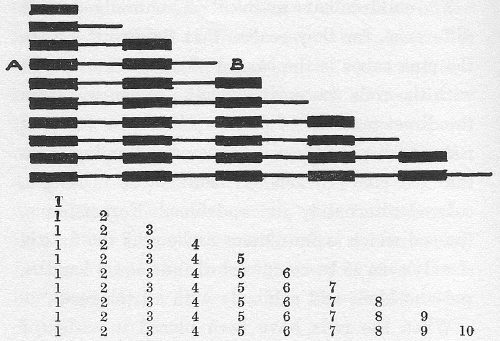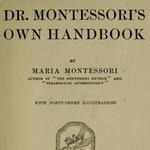Summary Chapter 06- 1914 - Dr Montessori Own Handbook
## **Summary Chapter 06 - 1914 - Dr. Montessori’s Own Handbook**
### **Short Summary**
This chapter from Dr. Montessori's Own Handbook discusses the Montessori approach to teaching arithmetic to young children. It emphasizes the use of concrete materials, such as rods and cubes, to develop a clear understanding of numbers and mathematical operations. The chapter highlights the importance of providing hands-on experiences and gradually introducing abstract symbols and concepts.

### **Facts**
* The materials for the education of the senses provide a foundation for understanding quantity, identity, and difference, which are essential for numeration.
* Three sets of materials are presented: pink cubes for teaching size, brown prisms for teaching thickness, and green rods for teaching length. The relationship between the pieces in each set corresponds to the natural series of numbers.
* The pink cubes represent the volumes of the series of numbers from one to ten, while the prisms represent the squares of the series of numbers.
* The rods, divided into ten spaces and colored alternately red and blue, are used to introduce the concept of numbers. The child learns to count and recognize separate rods, gradually increasing the numbers.
* The use of concrete materials, such as rods and cubes, helps children develop a clear understanding of numbers and mathematical operations.
* The transition from concrete materials to abstract symbols is facilitated by using sandpaper figures and number cards.
* Various exercises are introduced, including grouping objects according to the number they represent and using an arithmetic frame to understand tens and multiples of ten.
> ##### **The license of this page:**
>
> This page is part of the “**Montessori Restoration and Translation Project**”.
>
> Please [support](https://ko-fi.com/montessori) our “**All-Inclusive Montessori Education for All 0-100+ Worldwide**” initiative. We create open, free, and affordable resources available for everybody interested in Montessori Education. We transform people and environments to be authentic Montessori worldwide. Thank You!
>
> [](http://creativecommons.org/licenses/by-nc-sa/4.0/)
>
> **License:** This work with all its restoration edits and translations is licensed under a [Creative Commons Attribution-NonCommercial-ShareAlike 4.0 International License](http://creativecommons.org/licenses/by-nc-sa/4.0/).
>
> Check out the **Page History** of each wiki page in the right column to learn more about all contributors and edits, restorations, and translations done on this page.
>
> [Contributions](https://mariamontessori.xyz/s/montessorix/wiki/page/view?title=Contribute+to+Montessori+X) and [Sponsors](https://mariamontessori.xyz/s/montessorix/wiki/page/view?title=Support+Montessori+X) are welcome and very appreciated!
>
> ### The book itself is protected under **The Project Gutenberg License**
>
> [https://www.gutenberg.org/policy/license.html](https://www.gutenberg.org/policy/license.html)
>
> To protect the Project Gutenberg-tm mission of promoting the free distribution of electronic works, by using or distributing this work (or any other work associated in any way with the phrase “Project Gutenberg”), you agree to comply with all the terms of the Full Project Gutenberg-tm License available with this file or online at [www.gutenberg.org/license](https://www.gutenberg.org/license)
>
> **This eBook is for the use of anyone anywhere in the United States and most other parts of the world at no cost and with almost no restrictions whatsoever. You may copy it, give it away, or re-use it under the terms of the Project Gutenberg License included with this eBook or online at [www.gutenberg.org](http://www.gutenberg.org/). If you are not located in the United States, you’ll have to check the laws of the country where you are located before using this ebook.**
>
> Read this book on …
>
> **[Project Gutenberg](https://www.gutenberg.org/)**
>
> * [https://www.gutenberg.org/ebooks/29635](https://www.gutenberg.org/ebooks/29635)
>
> **[Archive.org](http://archive.org/)**
>
> * [https://archive.org/details/drmontessorisow01montgoog/](https://archive.org/details/drmontessorisow01montgoog/)
>
> * [https://archive.org/details/drmontessorisown01mont/](https://archive.org/details/drmontessorisown01mont/)
>
> * [https://archive.org/details/drmontessorisown00mont](https://archive.org/details/drmontessorisown00mont)
>
> * [https://archive.org/details/drmontessorisown29635gut](https://archive.org/details/drmontessorisown29635gut)
>
> **[Guides.co](https://guides.co/)**
>
> * [https://guides.co/g/montessori-handbook/31826](https://guides.co/g/montessori-handbook/31826)
* [Dr. Montessori's Own Handbook](https://montessori-international.com/s/montessoris-own-handbook/wiki/English "Dr. Montessori's Own Handbook") - English Restoration - [Archive.Org](https://archive.org/details/drmontessorisown01mont/page/n5/mode/2up "Dr. Montessori's Own Handbook on Archive.Org") - [Project Gutenberg](https://www.gutenberg.org/ebooks/29635 "Dr. Montessori's Own Handbook on Project Gutenberg")
* [0 - Chapter Index - Dr. Montessori's Own Handbook - Restoration](https://montessori-international.com/s/montessoris-own-handbook/wiki/0+-+Chapter+Index+-+Dr.+Montessori%27s+Own+Handbook+-+Restoration)
* [Chapter 00 – Dedication, Acknowledgements, Preface](https://montessori-international.com/s/montessoris-own-handbook/wiki/Chapter+00+%E2%80%93+Dedication%2C+Acknowledgements%2C+Preface)
* [Chapter 01 - Introduction - Children's House - The Method](https://montessori-international.com/s/montessoris-own-handbook/wiki/Chapter+01+-+Introduction+-+Children%27s+House+-+The+Method)
* [Chapter 02 - Motor Education](https://montessori-international.com/s/montessoris-own-handbook/wiki/Chapter+02+-+Motor+Education)
* [Chapter 03 - Sensory Education](https://montessori-international.com/s/montessoris-own-handbook/wiki/Chapter+03+-+Sensory+Education)
* [Chapter 04 - Language and Knowledge of the World](https://montessori-international.com/s/montessoris-own-handbook/wiki/Chapter+04+-+Language+and+Knowledge+of+the+World)
* [Chapter 05 - The Reading of Music](https://montessori-international.com/s/montessoris-own-handbook/wiki/Chapter+05+-+The+Reading+of+Music)
* [Chapter 06 - Arithmetic](https://montessori-international.com/s/montessoris-own-handbook/wiki/Chapter+06+-+Arithmetic)
* [Chapter 07 - Moral Factors](https://montessori-international.com/s/montessoris-own-handbook/wiki/Chapter+07+-+Moral+Factors)


